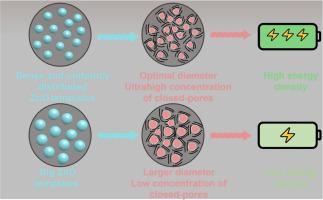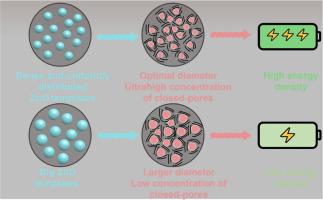Regulating closed-pore concentration of hard carbon for ultrahigh plateau capacity sodium-ion batteries
IF 20.2
1区 材料科学
Q1 CHEMISTRY, PHYSICAL
引用次数: 0
Abstract
Constructing closed-pore structures provides an effective strategy to enhance the plateau capacity of hard carbon (HC) anodes in sodium-ion batteries. However, the ambiguous role of closed-pore size, volume, and particularly the less-reported closed-pore concentration in governing plateau capacity hinders the rational design of closed-pore structures. Herein, we develop a hydrothermal zinc oxide template approach that precisely regulates closed-pore size, volume, and concentration through precursor zinc content modulation, thereby investigating the critical determinants of plateau capacity. Electrochemical analysis reveals a lack of positive correlation between individual closed-pore size/volume metrics and plateau capacity. We establish a quantitative formula for calculating closed-pore concentration, confirming this parameter delivers a significant linear correlation with plateau capacity. The optimized HC-2 sample with highest closed-pore concentration (2.00 × 1021 g−1) exhibits a high-reversible capacity of 466.7 mAh g−1 and exceptional plateau capacity of 371 mAh g−1. This work establishes a closed-pore engineering paradigm from precursor design to structural control, providing fundamental insights for developing high-concentration closed-pore HC anodes.


调节超高平台容量钠离子电池硬碳闭孔浓度
构建闭孔结构是提高钠离子电池硬碳(HC)阳极平台容量的有效策略。然而,闭孔大小、体积,特别是较少报道的闭孔浓度在控制平台容量方面的模糊作用阻碍了闭孔结构的合理设计。在此,我们开发了一种热液氧化锌模板方法,通过前驱体锌含量调节精确调节闭孔大小,体积和浓度,从而研究平台容量的关键决定因素。电化学分析表明,单个封闭孔径/体积指标与平台容量之间缺乏正相关关系。我们建立了计算闭孔浓度的定量公式,证实该参数与平台容量具有显著的线性相关性。优化后的HC-2样品具有最高的闭孔浓度(2.00 × 1021 g−1),具有466.7 mAh g−1的高可逆容量和371 mAh g−1的优异平台容量。这项工作建立了从前驱体设计到结构控制的闭孔工程范式,为开发高浓度闭孔HC阳极提供了基础见解。
本文章由计算机程序翻译,如有差异,请以英文原文为准。
求助全文
约1分钟内获得全文
求助全文
来源期刊

Energy Storage Materials
Materials Science-General Materials Science
CiteScore
33.00
自引率
5.90%
发文量
652
审稿时长
27 days
期刊介绍:
Energy Storage Materials is a global interdisciplinary journal dedicated to sharing scientific and technological advancements in materials and devices for advanced energy storage and related energy conversion, such as in metal-O2 batteries. The journal features comprehensive research articles, including full papers and short communications, as well as authoritative feature articles and reviews by leading experts in the field.
Energy Storage Materials covers a wide range of topics, including the synthesis, fabrication, structure, properties, performance, and technological applications of energy storage materials. Additionally, the journal explores strategies, policies, and developments in the field of energy storage materials and devices for sustainable energy.
Published papers are selected based on their scientific and technological significance, their ability to provide valuable new knowledge, and their relevance to the international research community.
 求助内容:
求助内容: 应助结果提醒方式:
应助结果提醒方式:


